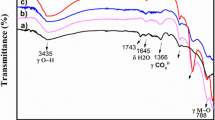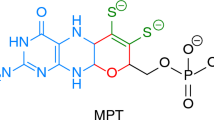Conclusions
-
1.
At 170°C silico-12-molybdic acid (SMA) exhibits oxidative characteristics and simultaneous catalytic action in reactions with a series of organic oxygen-containing compounds. The oxidation of primary alcohols by SMA leads to a mixture of ethers, esters, and acetals. The formation of olefins, carboxylic acids, and aldehydes is also possible, and their yields increase with increase in temperature.
-
2.
In the reaction of SMA with acetaldehyde and acetone condensation reactions also take place to a significant degree, in addition to the oxidation-reduction processes.
-
3.
The SMA exhibits significantly higher activity than its neutral potassium salt both in stoichiometric oxidation reactions and in catalytic dehydration reactions. This is determined by the role of the Brönsted acidity of the heteropoly complex in the investigated processes.
-
4.
The reaction of silico-12-tungstic acid with ethanol leads to a mixture of olefins and alkanes.
Similar content being viewed by others
Literature cited
N. A. Polotebnova, L. T. Migunova, Yu. S. Genshaft, and V. V. Krasnoshchekov, Z. Neorg. Khim.,24, 234 (1978).
L. Charley, J. Opt. Soc. Am.,44, 699 (1954).
H. Niiyama, H. Tsuneki, and E. Echigoya, J. Chem. Soc. Jpn. Chem. Ind. Chem., 996 (1979).
G. A. Tsigdinos, Heteropoly Compounds of Molybdenum and Tungsten. Topics in Current Chemistry, 76. Aspects of Molybdenum and Related Chemistry, Berlin, New York: Springer-Verlag (1978).
K. Sakata, Ya. Konisi, M. Misono, and Yu. Ioneda, Catalyst,21, 307 (1979).
K. Nomiya, T. Ueno, and M. Miwa, Bull. Chem. Soc. Jpn.,53, 827 (1980).
K. Nomiya, V. Sugaya, S. Sasa, and M. Miwa, Bull. Chem. Soc. Jpn.,53, 2089 (1980).
F. McLafferty, Interpretation of Mass Spectra, W. A. Benjamin, New York (1973).
L. J. Bellamy, Infrared Spectra of Complex Molecules, Wiley, New York (1958).
K. Nomiya, S. Sasa, and M. Miwa, Chem. Lett., 1075 (1980).
Yu. N. Ermakov, V. A. Zakharov, and B. N. Kuznetsov, Fixed Complexes on Oxide Supports in Catalysis [in Russian], Nauka, Novosibirsk (1980).
J. M. Tatibouet and J. E. Germain, Compt. Rend. Acad. Sci.,289C, 301 (1979).
J. M. Tatibouet and J. E. Germain, Compt. Rend. Acad. Sci.,289C, 305 (1979).
J. M. Tatibouet and J. E. Germain, Compt. Rend. Acad. Sci.,290C, 16 (1980).
Author information
Authors and Affiliations
Additional information
Translated from Izvestiya Akademii Nauk SSSR, Seriya Khimicheskaya, No. 4, pp. 798–802, April, 1982.
Rights and permissions
About this article
Cite this article
Pinchuk, I.N., Chuvaev, V.F., Ovchinnikova, N.S. et al. Reaction of organic oxygen-containing compounds with some heteropoly complexes. Russ Chem Bull 31, 703–706 (1982). https://doi.org/10.1007/BF00950002
Received:
Issue Date:
DOI: https://doi.org/10.1007/BF00950002




